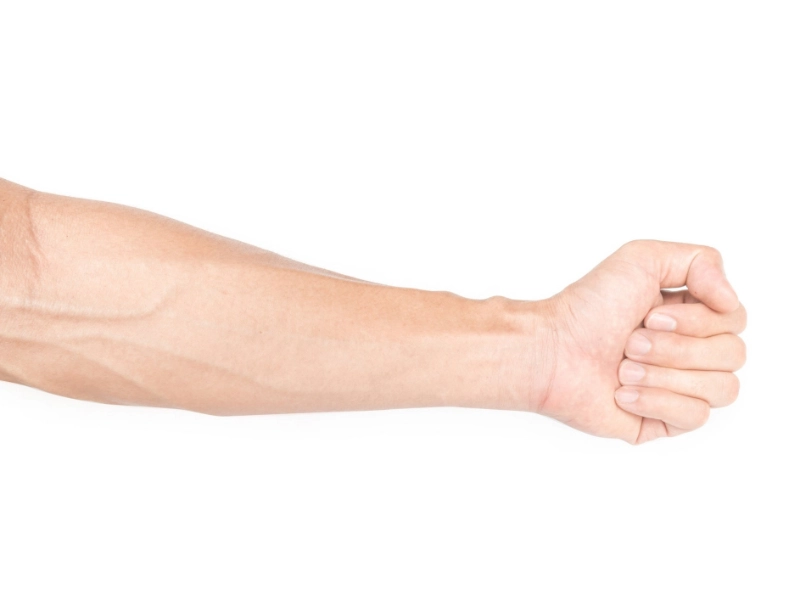Climbing rocks provides an aerobic and total body workout. Inexperienced climbers risk developing muscular imbalances if they don't mix in other types of workout with their regimen. Due to consistent climbing practice, experienced climbers typically have more developed back muscles and forearm flexors than beginners. The use of safety equipment when travelling helps to strengthen these muscles as well.

 Both your biceps and your lats, which are the second main muscle group, get stronger when you rock climb. The large, wing-shaped muscles in your back that pull your body up and towards the wall are called the latissimus dorsi muscles. Along with the anterior deltoid and rhomboids, they also stabilise your shoulders.
When you smeared on a slab or death clutch a protruding ledge, your muscles are put to the test. Gaining strength in your biceps can help you hold that posture and lessen the chance of getting hurt when the route grows steeper or the climb gets harder.
Due to the intense training that climbing offers for the pull muscles while placing less strain on the opposing push muscles of the chest, shoulders, and upper arms, climbers are more likely to develop muscular imbalances. This may result in a climber's hunch, rounded shoulders, and back muscles that need for specialised chiropractic care. You can lessen this imbalance and improve your general strength by engaging in rock climbing twice or three times a week along with a normal training regimen.
Both your biceps and your lats, which are the second main muscle group, get stronger when you rock climb. The large, wing-shaped muscles in your back that pull your body up and towards the wall are called the latissimus dorsi muscles. Along with the anterior deltoid and rhomboids, they also stabilise your shoulders.
When you smeared on a slab or death clutch a protruding ledge, your muscles are put to the test. Gaining strength in your biceps can help you hold that posture and lessen the chance of getting hurt when the route grows steeper or the climb gets harder.
Due to the intense training that climbing offers for the pull muscles while placing less strain on the opposing push muscles of the chest, shoulders, and upper arms, climbers are more likely to develop muscular imbalances. This may result in a climber's hunch, rounded shoulders, and back muscles that need for specialised chiropractic care. You can lessen this imbalance and improve your general strength by engaging in rock climbing twice or three times a week along with a normal training regimen.
 Climbing provides an excellent workout for the core in addition to being a wonderful technique to develop upper body strength. Extremely tense and in an unstable position, climbers employ their abdominal muscles to maintain their centre of gravity.
The climbing motion also works the hamstring and lower back muscles. These muscles can be developed through climbing, but in order to avoid damage, these muscles must be trained correctly.
Because climbing demands substantial shoulder muscles to sustain the climber's bodyweight, climbers generally have stronger and more toned shoulders than beginners. When rock climbing, the medial or middle deltoids are worked by lifting the arms out to the side, and the front, lateral, or anterior deltoid muscle is worked by pushing the arm forward and upward. When climbing, the rotator cuff muscles are also utilised. Climbing exercises like the dead bug strengthen these muscles, which are used in the rotation of the arms at the shoulder joint.
Climbing provides an excellent workout for the core in addition to being a wonderful technique to develop upper body strength. Extremely tense and in an unstable position, climbers employ their abdominal muscles to maintain their centre of gravity.
The climbing motion also works the hamstring and lower back muscles. These muscles can be developed through climbing, but in order to avoid damage, these muscles must be trained correctly.
Because climbing demands substantial shoulder muscles to sustain the climber's bodyweight, climbers generally have stronger and more toned shoulders than beginners. When rock climbing, the medial or middle deltoids are worked by lifting the arms out to the side, and the front, lateral, or anterior deltoid muscle is worked by pushing the arm forward and upward. When climbing, the rotator cuff muscles are also utilised. Climbing exercises like the dead bug strengthen these muscles, which are used in the rotation of the arms at the shoulder joint.
 Strong grip strength from the forearm muscles is essential for climbing. Without using these muscles and gradually strengthening them, climbing is not possible for very long. The larger muscles in your body, particularly the ones in your shoulders and upper back, are also worked out by rock climbing. They facilitate the transfer of muscle strain from your forearms, enabling you to climb longer routes more effectively.
Although ectomorphs with long muscles can gradually build up their forearms as they climb more, forearm size is mainly inherited. They can get them really jacked up, but they might not be able to grow them as big as the ripped boulderers you see at outdoor climbing gyms.
Strength and endurance in the grip can be increased by forearm training. Forearm endurance can be greatly increased by repeatedly performing low-stress exercises like raising up on a bar with both arms, dropping one hand and shaking off your forearm for about five seconds before switching.
Strong grip strength from the forearm muscles is essential for climbing. Without using these muscles and gradually strengthening them, climbing is not possible for very long. The larger muscles in your body, particularly the ones in your shoulders and upper back, are also worked out by rock climbing. They facilitate the transfer of muscle strain from your forearms, enabling you to climb longer routes more effectively.
Although ectomorphs with long muscles can gradually build up their forearms as they climb more, forearm size is mainly inherited. They can get them really jacked up, but they might not be able to grow them as big as the ripped boulderers you see at outdoor climbing gyms.
Strength and endurance in the grip can be increased by forearm training. Forearm endurance can be greatly increased by repeatedly performing low-stress exercises like raising up on a bar with both arms, dropping one hand and shaking off your forearm for about five seconds before switching.